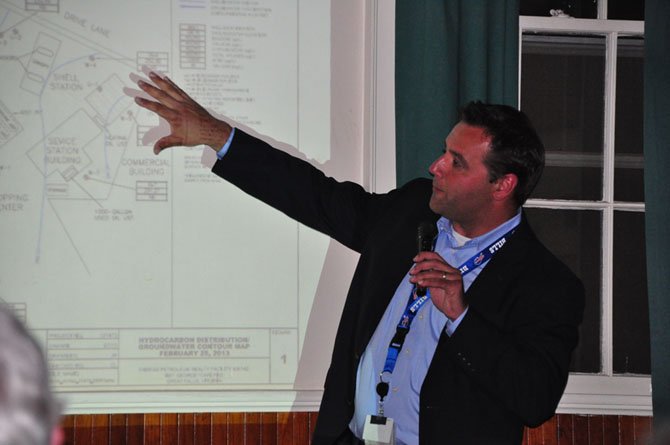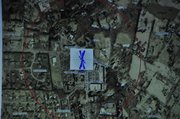Kurt Kochan, of the Virginia Department of Environmental Quality, speaks at the Grange about contamination of the former Exxon station at the corner of Walker Road and Georgetown Pike. Photo by Alex McVeigh.
Great Falls — Great Falls residents gathered at the Grange Tuesday, May 14 to hear the latest on the contaminated site at the corner of Georgetown Pike and Walker Road, and to hear plans for its cleanup.
A TD Bank branch has been proposed for the property, and is currently being reviewed by Fairfax County staff. But the lot’s previous history is what is causing worry.
A gas station opened at the location in 1969, which meant underground fuel tanks were put in. Those tanks were removed and ones that met new regulations were installed in the 1990s, which were in use until they were removed last year.
In August 2009, the Virginia Department of Environmental Quality was informed of the presence of "dissolved phase petroleum constituents" located on the Exxon property. That month, Exxon began testing 20 of the 21 potable wells located within a quarter mile of the station. One landowner declined the test.
"At that point in time, the station had a potable well that they were using for the bathroom and coffee, things like that, and that well was found to be contaminated," said Kurt Kochan, a remediation specialist with the Virginia DEQ. "The first thing we asked them to look at was, is it continuing to leak, is it new, is it old, is it ongoing? It is a high risk area, because there a lot of folks on well water, so there was immediate concern, given levels on site."
Methyl tertiary-butyl ether (MTBE) was the chemical found to be present in the water. It was present in local gasoline until 2006. The Virginia Department of Health has a threshold of 15 parts per billion of MTBE in drinking water, but the Virginia DEQ has a zero tolerance practice for MTBE and other petroleum constituents in private water supply wells such as those found in Great Falls.
IN MARCH 2010, Fairfax Petroleum assumed responsibility for required analysis of the site and corrective actions, as part of the purchase of the site.
In August 2012, a DEQ contractor sampled 21 nearby potable water residential wells that supply drinking water. Currently, 17 monitoring wells, as well as the potable well at the former Exxon station, are being monitored.
"Three and a half years later, we have collected a lot of data, and we have a pretty good understanding of what’s going on in the subsurface of the site, and the responsible party is in the process of creating a corrective action plan to address this," he said. "The problem is localized, meaning confined to mostly on the site, from what we’re seeing. We have deep wells offsite, and there’s significant levels onsite, but we have not seen them offsite. The data has shown that no quantified concentrations of any petroleum contaminants above the method detection limit have been reported in samples collected from off-site potable wells."
Great Falls resident Eric Knudsen, who lives just south of the former Exxon station, says his well was tested after the contamination was discovered, and a "measurable amount" was discovered. He said he’s concerned that further testing has not been up to par.
"When they tested my well the first time, they found something. It was not tested that same way again," he said. "The first test was done where they had to run my water at the source where it came into the house for 20 minutes. Then they had to take several samples at that point. Then they went off and got a reading. The next time, they came out to same point, took the water but did not run it for 20 minutes. After that, it became subcontractors where they maybe came in the house and went to the sink, then they got it from the outside faucet."
Kochan said that changes to testing protocol could be expected as more monitoring wells were dug.
"Once they set the perimeter of monitoring wells, real monitoring wells, not the ones going into houses, that is the point at which they start to monitor those wells," he said.
Other residents were concerned with data that showed spikes in the levels of MBTE parts per million, especially since no new MBTE would have been introduced since it was removed from gasoline in 2006.
Great Falls sits on bedrock made of schist, which has fractures in it. Carol Stone, a water quality specialist with the Chesapeake Bay Foundation, said that this type of bedrock can lead to trouble when it comes to contaminants.
"If something that gets into the water from the ground and gets into a fracture and it can travel long distances, it’s not a gradual diffusion kind of thing," she said. "Something that you do on your property could stay on your property or affect someone 3 miles down the road."
DEQ GEOLOGISTS say the major bedrock fractures run north to south parallel with Walker Road, at a variation of about 15 degrees on each side.
Kochan pointed out that the contamination is not likely to be the result of a single spill, or leaking tanks.
"There’s not a smoking gun out there. The tanks were tested afterwards, and passed the testing, they met the regulatory threshold. In our experience, when you have cases where there is a lot of MTBE and not a lot of other gasoline components, they’re vapor releases. In this area we’re trying to capture vapor when people are pumping gas, and there are small leaks over time that get out through fittings that have likely led to the release. There was not a hole in the tank, or anything like what we call a ‘catastrophic release’ where you have gasoline leaking at a high rate into the subsurface."
Kleinfelder, an architecture, engineering and science firm, has been hired by Fairfax Petroleum and is responsible for conducting testing and developing a corrective action plan to be submitted to the DEQ. After a plan is developed, there will be a public comment period of 60 days, after which any plan must be recommended by Kochan and eventually approved or not approved by the DEQ.

